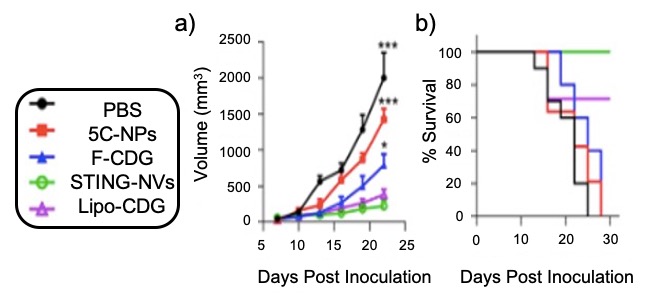Cancer Treatment
Novel Drug Delivery Method for Immunotherapy Treatment
Delivery of Potent STING Activating Nanovaccine
Cancer affects roughly 2 million patients a year in the United States alone. Most commonly, treatment includes surgical, chemotherapeutic, and immunotherapeutic steps to remove, kill, and prevent the growth and spread of the cancer cells. Unfortunately, delivery of chemotherapy and immunotherapy agents can be challenging. Variables such as hydrophilicity, charge, molecule size, and enzymatic degradation all have significant roles in the ability to successfully deliver these agents. Researchers at Virginia Commonwealth University (VCU) have developed a novel immunotherapy agent delivery method that circumvents these challenges.
The technology
This novel drug delivery method utilizes a nanoparticle core comprised of FDA approved polymers. These cores are then coated in a pH-sensitive DNA structure. This DNA structure can be tailored to have a high binding affinity for immunotherapy agents, including STING agonists, which are a group of interferon stimulating molecules. These molecules, which are extremely potent immunotherapy agents, are difficult to deliver because of their charge, hydrophilicity, rapid degradation upon administration, and difficulty of endosome escape upon endocytosis in cells. By utilizing the pH-sensitive nature of the DNA structure, the STING agonist, CDG, is able to be encapsulated and delivered to the cells successfully. Upon delivery, the low pH environment associated with endocytosis releases the CDG molecule successfully within the cell. Evaluation of this novel nanovaccine delivery method in a melanoma tumor model yielded a 100% survival rate 30 days after treatment compared to a roughly 60% survival rate when using current gold-standard liposomal CDG which can be seen in the figure below.

Figure 1. Shown above is (a) the resulting changes in tumor volume and (b) the percent survival rate of mice that are injected with a melanoma tumor and then treated with either PBS, the DNA-coated nanoparticle alone, CDG alone, CDG encapsulated in the novel STING nanovaccine particle (STING-NV), or a lipid encapsulated CDG.
